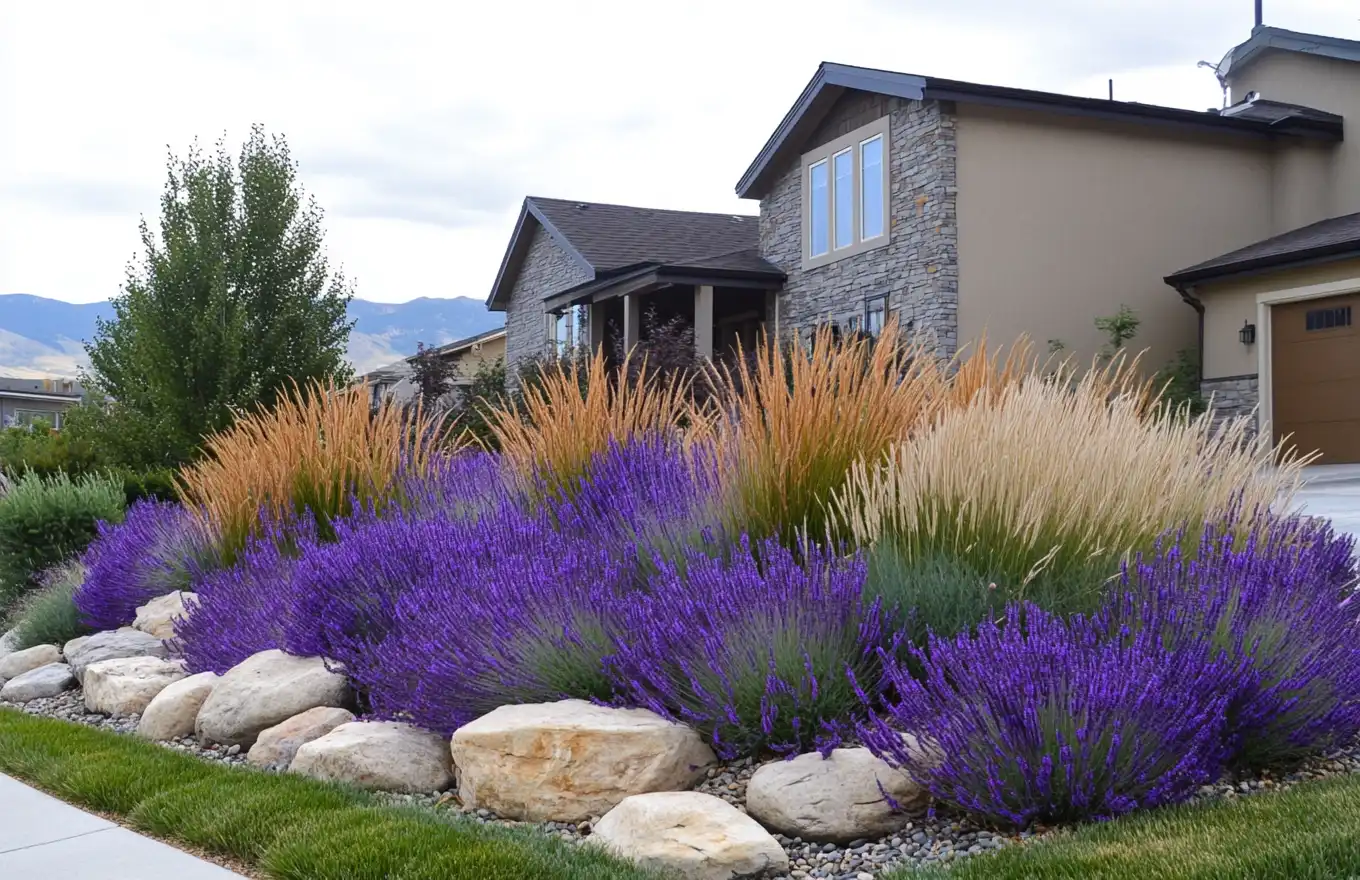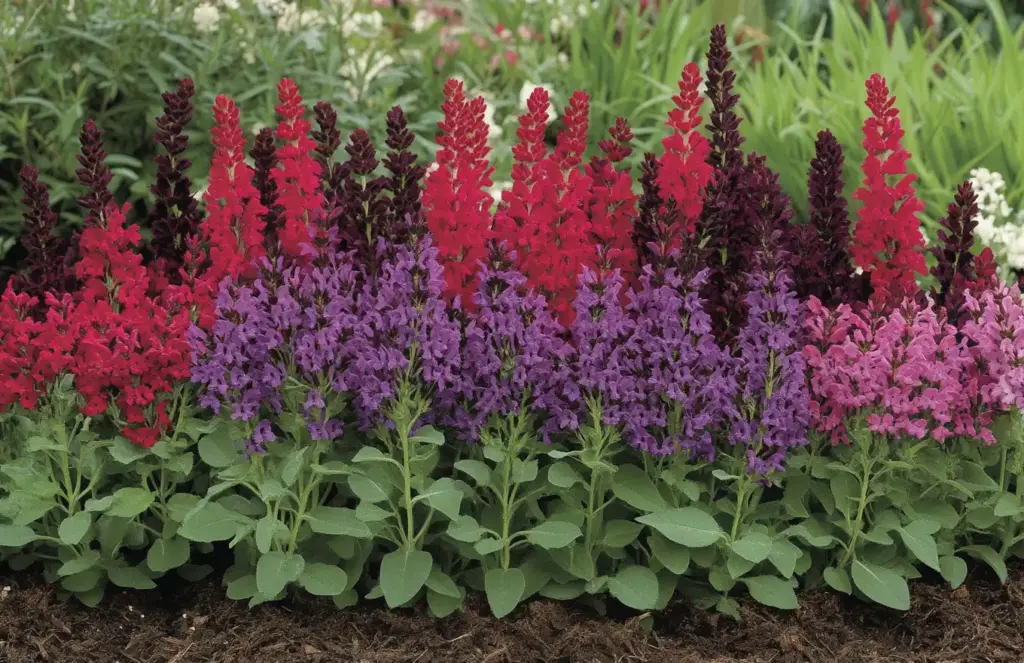Salvia plant lovers, get ready to grow lush blooms and fragrant foliage with ease. Known for their resilience and vibrant color, salvias are a favorite for gardens, containers, and pollinator-friendly spaces. Whether you’re a beginner or seasoned gardener, mastering salvia care—from choosing the right variety to pruning and propagation—will help your plants thrive from spring through fall.
Table of Contents
🌱 1. Understanding Salvia Plants
The salvia plant belongs to the Salvia genus—a vast group within the mint family (Lamiaceae) with over 900 unique species found worldwide. These plants range from annuals to hardy perennials and even small woody shrubs, each bringing a splash of color and fragrance to gardens and patios.
Salvias are beloved for their:
- Aromatic leaves – a signature trait, especially in culinary varieties like common sage
- Vibrant flowers – often forming spiky clusters in shades of purple, red, blue, pink, and white
- Diverse forms – including compact ground covers, upright bloomers, and shrubby types
Some standout varieties include:
- Common Sage (Salvia officinalis) – a culinary staple
- Scarlet Sage (Salvia splendens) – fiery red blooms, popular in warm climates
- Woodland Sage (Salvia nemorosa) – low-growing and perfect for borders
- Mexican Sage (Salvia leucantha) – soft, velvety flowers favored by pollinators
Understanding the species you’re working with is vital. Some salvias are drought-tolerant sun-lovers, while others prefer cooler zones or partial shade. Taking time to learn their traits helps ensure your salvia plant care approach fits their needs perfectly.
🌼 2. How to Select the Right Salvia
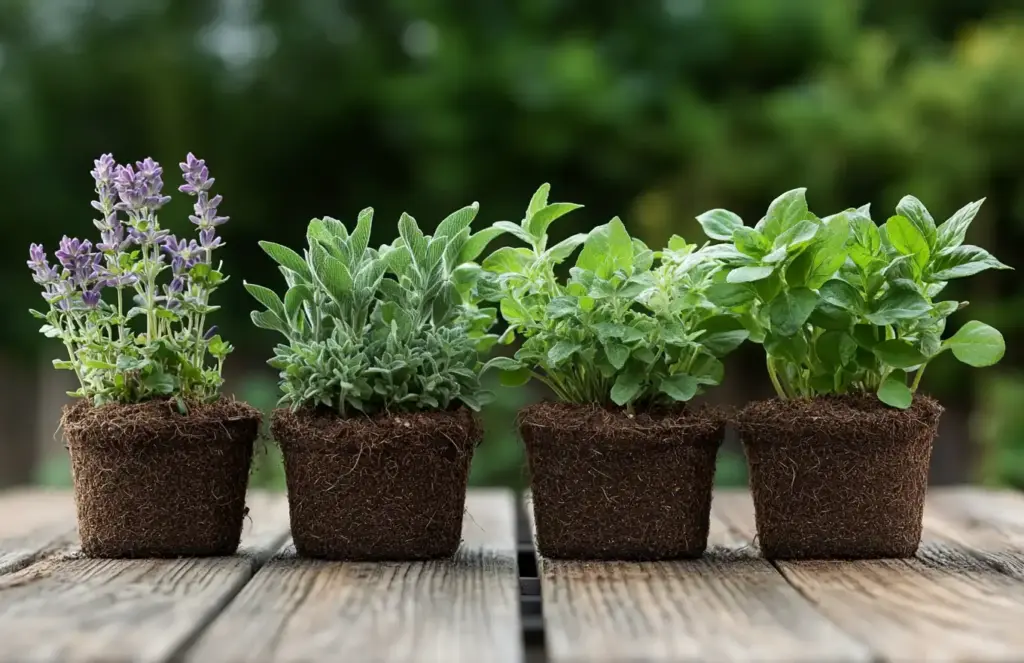
Choosing the right salvia plant for your garden goes beyond picking a pretty flower. To ensure healthy growth and vibrant blooms, you’ll need to match the plant’s preferences with your local conditions and gardening goals.
✅ Factors to Consider:
- Climate Zone: Some salvia varieties are frost-tolerant perennials, while others, like tropical salvias, thrive in heat and humidity. For example, Scarlet Sage performs best in warmer zones, while Woodland Sage can handle cooler regions.
- Soil Type: Salvia prefers well-drained soil. Check if your soil leans sandy, loamy, or clay-heavy—and amend as needed with compost or organic matter.
- Garden Space: Whether you’re planting in borders, raised beds, or pots, make sure the variety fits the space. Some salvias can sprawl over 3 feet, while others stay compact.
- Intended Use:
- Culinary – Choose Common Sage for its earthy flavor
- Ornamental – Opt for colorful varieties like Mexican Sage
- Medicinal or Pollinator-Friendly – Many salvias support bee and butterfly habitats
🪴 What to Look for When Buying:
- Healthy foliage: Look for bright, undamaged leaves
- Sturdy stems: Avoid limp or weak-looking growth
- Pest-free condition: Check for aphids, whiteflies, or sticky residue
- Root health: If possible, inspect the root ball. It should be firm and white—not root-bound or soggy
By selecting the right salvia plant to suit your needs and garden environment, you’ll set yourself up for success right from the start.
☀️ 3. Essential Growing Conditions
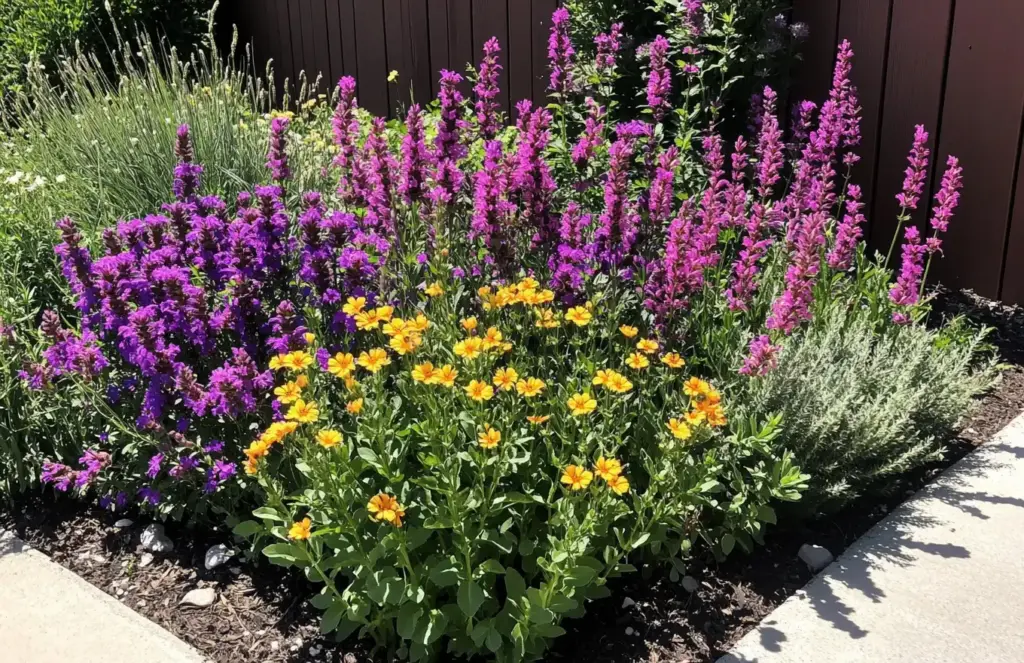
To thrive, every salvia plant needs a foundation of the right light, soil, and environmental support. Here’s how to create the perfect growing environment to get the most blooms and healthiest foliage.
🌞 Light: Full Sun is Best
Most salvia plants crave sunshine. Aim for at least 6 hours of direct sunlight daily, especially for varieties like Scarlet Sage or Mexican Sage, which are sun-lovers. While a few types tolerate partial shade, full sun ensures more prolific blooming and sturdier stems.
🌱 Soil: Drainage is Critical
Salvias do not like “wet feet.” For best results:
- Use well-draining soil
- Maintain a slightly acidic to neutral pH (6.0 to 7.0)
- Add organic compost to improve heavy clay or sandy soils
- Raised beds or mounded planting areas can also help avoid soggy roots
🌡️ Temperature & Humidity
Salvia plants are relatively tolerant once established but have a few limits:
- Heat: While many salvias enjoy warmth, extreme heat can cause stress. Provide light afternoon shade in very hot regions.
- Cold: Most salvias aren’t frost-hardy. In colder zones, treat tender types as annuals or overwinter them indoors.
- Humidity: Good air circulation is a must in humid areas. Plant with spacing in mind to prevent fungal diseases like powdery mildew.
By tailoring these conditions to your specific salvia plant, you’ll build a thriving environment where they can bloom season after season.
🪴 4. Planting Salvia
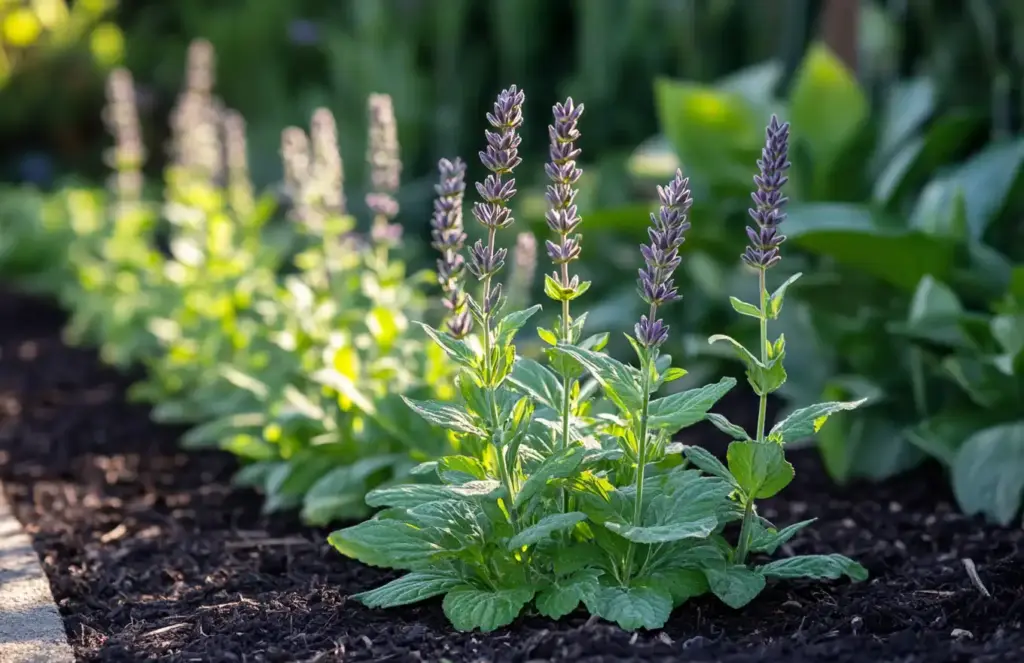
Planting your salvia plant at the right time and in the right way sets the stage for healthy roots, vigorous growth, and colorful blooms. Here’s a foolproof planting plan to get your salvias off to a strong start.
🗓️ When to Plant
- Spring is ideal—after the last frost—giving the plant a full season to establish before winter.
- In warm regions, fall planting also works well, especially for perennial varieties.
- Avoid planting in peak summer heat, which can stress young transplants.
📏 How to Space and Arrange
Proper spacing prevents overcrowding and encourages airflow:
- Small varieties: Space 12–18 inches apart
- Medium to tall varieties: 18–36 inches apart
- Group in odd numbers (3s or 5s) for a natural, balanced look in borders or containers
🌿 Step-by-Step Planting Guide
- Dig a hole twice the width and the same depth as the root ball.
- Loosen the roots gently, especially if root-bound.
- Place the plant in the hole, keeping the top of the root ball level with the surrounding soil.
- Backfill with soil, firming it gently around the base.
- Water thoroughly to eliminate air pockets and help roots settle.
💡 Pro Tip: Mulch around your salvia plant with organic material (like shredded bark or straw) to conserve moisture, suppress weeds, and regulate soil temperature.
💧 5. Watering and Feeding
Mastering how to water and feed your salvia plant can mean the difference between a struggling sprout and a garden showstopper. Salvias are relatively low-maintenance, but getting the balance right is key.
💦 How to Water Salvia
- Water deeply at the base of the plant—this encourages strong root development
- Avoid overhead watering, which can lead to fungal issues like powdery mildew
- Allow the top inch of soil to dry out between waterings
As a rule of thumb:
- New transplants: Water every 2–3 days for the first couple of weeks
- Established plants: Water once a week, adjusting for rain and climate
🚫 Watch for Signs of Trouble
- Overwatering: Yellowing leaves, mushy roots, and fungal diseases
- Underwatering: Wilting, browning edges, and stunted growth
🌿 Feeding Your Salvia Plant
Feed salvia once or twice during the growing season to support lush foliage and vibrant blooms.
- Use a balanced, slow-release fertilizer in early spring
- A second feeding in mid-summer may boost repeat flowering
- Avoid high-nitrogen formulas, which promote leafy growth over blooms
💡 Natural Boost: Compost or worm castings offer gentle, steady nutrition without the risk of over-fertilizing.
With a smart watering routine and light feeding schedule, your salvia plant care strategy will keep your garden thriving all season long.
✂️ 6. Pruning and Maintenance
Proper pruning is the secret to keeping your salvia plant compact, healthy, and full of flowers. With just a little seasonal maintenance, you can encourage continuous blooming and prevent pests or diseases from taking hold.
🏵️ Deadheading and Shaping
- Deadhead regularly by snipping off spent blooms—this encourages new flower spikes
- Trim leggy stems mid-season to rejuvenate growth and maintain a bushier shape
- For perennial salvias, cut back hard in late fall or early spring to stimulate new basal shoots
🐛 Pest Watch: Common Issues
Even hardy plants like salvia aren’t immune to occasional pests. Stay ahead by inspecting weekly.
Common pests include:
- Aphids – small green or black insects that cluster on stems
- Spider mites – look for webbing and stippled leaves
- Thrips – cause silver streaks or distorted new growth
🧴 Solutions:
- Use neem oil, insecticidal soap, or horticultural oils
- Rinse off light infestations with a firm blast of water
- Encourage natural predators like ladybugs
🍄 Disease Prevention
Salvias are susceptible to fungal issues in overly damp or humid conditions.
To prevent diseases:
- Avoid overhead watering
- Space plants properly for airflow
- Clean up fallen debris and dead foliage regularly
- If you notice powdery mildew or root rot, act fast—remove infected parts and treat with a fungicide if needed
Routine salvia plant care through pruning, cleanliness, and vigilance can keep these vibrant bloomers in peak form throughout the season.
🌿 7. Propagation Techniques
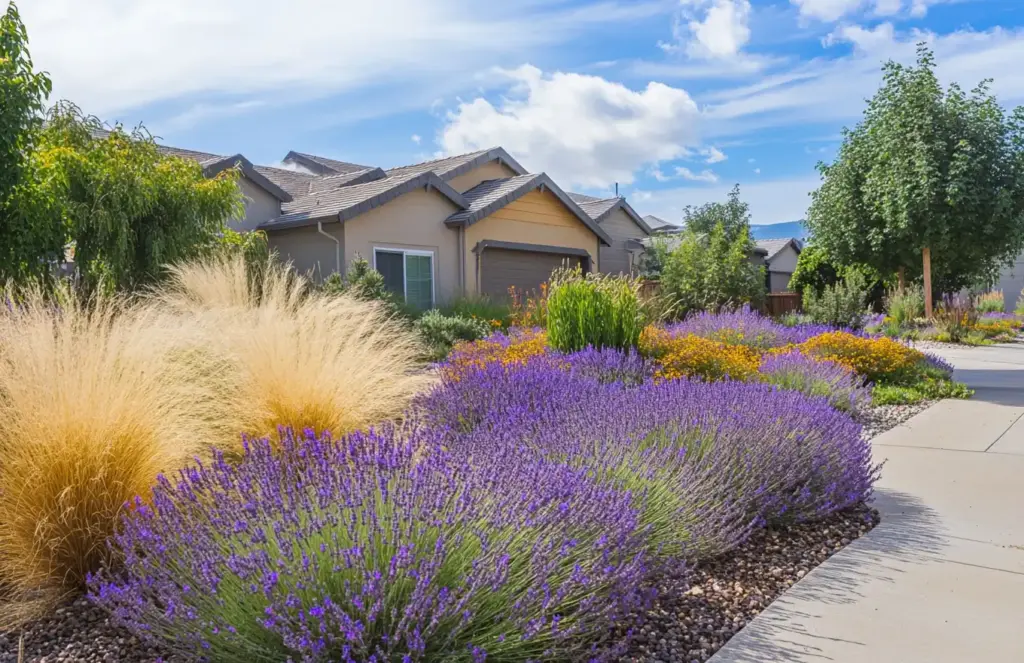
Want more blooms without buying new plants? Salvia plant propagation is easy and rewarding, giving you fresh starts from seeds, cuttings, or divisions. Whether you’re expanding your garden or sharing with friends, here’s how to do it right.
🌱 Growing Salvia from Seeds
Seed-starting works well for annual or hardy perennial types.
Step-by-step:
- Collect seeds from dried flower heads or purchase fresh packets
- Sow in a light seed-starting mix, barely covering with soil
- Keep moist and warm (70–75°F) using a heat mat or sunny windowsill
- Transplant when true leaves appear and seedlings are strong
💡 Tip: Start seeds indoors 6–8 weeks before the last frost for a head start on the season.
✂️ Propagating from Cuttings
This is one of the quickest ways to clone a mature salvia plant—perfect for perennials.
Steps:
- Snip a 4–6 inch stem cutting just below a node (avoid flowering stems)
- Strip off lower leaves and dip in rooting hormone
- Insert into moist, well-draining potting mix
- Cover loosely with plastic to maintain humidity
- Keep in bright, indirect light—roots should form in 2–3 weeks
🌸 Division for Established Plants
For woody or clumping salvias, division gives you instant full-sized plants.
How to divide:
- Dig up a mature plant in spring or fall
- Gently separate root clumps with your hands or a clean knife
- Replant divisions immediately and water well
By mastering these salvia plant care techniques, you can easily fill your garden with healthy, home-grown salvias season after season.
🌸 8. Creative Uses of Salvia
Once you’ve mastered salvia plant care, it’s time to enjoy the full beauty and utility these plants offer. Salvias aren’t just stunning—they’re multifunctional powerhouses in the landscape, the kitchen, and even your wellness routine.
🌺 In Garden Design
Salvias bring bold color, movement, and texture to every type of garden. Use them to:
- Add vertical interest in borders with tall, spiky blooms
- Fill containers with cascading or compact varieties
- Create striking color contrasts with complementary plants like coneflowers or black-eyed Susans
- Add a season-long show, as many salvias bloom from spring through frost
🐝 Companion Planting & Pollinator Zones
Few plants attract beneficial insects like salvia.
- Pollinators love them: Bees, butterflies, and hummingbirds flock to their nectar-rich flowers
- Repel pests naturally: Their aromatic oils deter harmful insects like cabbage moths and carrot flies
- Great companions for vegetables like tomatoes, cucumbers, and carrots
Planting salvia among crops improves biodiversity and reduces the need for pesticides.
🍽️ Culinary & Medicinal Uses
Some types of salvia, especially common sage (Salvia officinalis), have practical uses beyond the flower bed.
Culinary uses:
- Season poultry, stuffing, sauces, and savory dishes
- Brew into herbal teas
Medicinal properties (traditional use):
- Supports digestion
- Soothes sore throats
- Enhances memory and focus
🌿 Note: Not all salvia species are edible—always verify the variety before using internally.
With their versatility, salvia plants add value far beyond their blooms—making them a favorite of both ornamental gardeners and practical homesteaders.
🏁 9. Final Thoughts
Growing a salvia plant is a rewarding experience for gardeners of all levels. With vibrant blooms, pest-repelling properties, and even culinary uses, salvias offer beauty and function. Give them sunlight, well-drained soil, and occasional pruning, and they’ll reward you with long-lasting color and buzzing pollinators all season.
Whether in borders, containers, or pollinator gardens, salvia combines low maintenance with high impact—making it a true standout in any landscape.
❓Frequently Asked Questions About Salvia Plant Care
🌱 What is the best time of year to plant salvia?
The best time to plant salvia is in early spring, after the last frost. In warmer climates, fall planting is also ideal, giving roots time to establish before the next growing season.
☀️ Does salvia need full sun or partial shade?
Most salvia plants thrive in full sun, needing at least 6 hours of direct light daily. Some varieties tolerate partial shade, but full sun promotes stronger growth and more abundant flowering.
💧 How often should I water salvia?
Water salvia once a week during the growing season. Always check the top inch of soil—if it’s dry, it’s time to water. Avoid overwatering, which can lead to root rot.
✂️ When and how should I prune salvia?
Prune salvia:
Deadhead spent blooms regularly for continuous flowering
Lightly trim in mid-season to maintain shape
Hard prune perennial types in late fall or early spring to encourage fresh growth
🌿 Can I grow salvia in containers?
Yes! Many salvia varieties do well in pots. Use well-draining soil, ensure at least 6 hours of sun, and water when the topsoil feels dry. Container salvias are ideal for patios and balconies.
🌸 Do salvia plants attract pollinators?
Absolutely. Salvia plants are magnets for bees, butterflies, and hummingbirds. Plant them in pollinator gardens or near vegetable beds to enhance biodiversity and boost crop yields.
🍽️ Is salvia edible?
Only some types—common sage (Salvia officinalis) is edible and used in cooking. Other ornamental salvias are not meant for consumption, so always verify the species before using them in food or tea.
🌿 Love gardening inspiration? Follow me on Pinterest for bold plant ideas, tips, and seasonal color!

